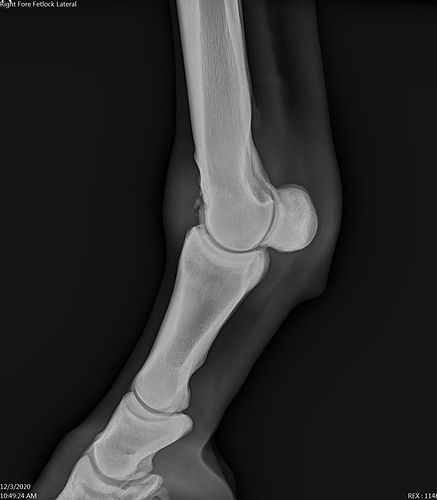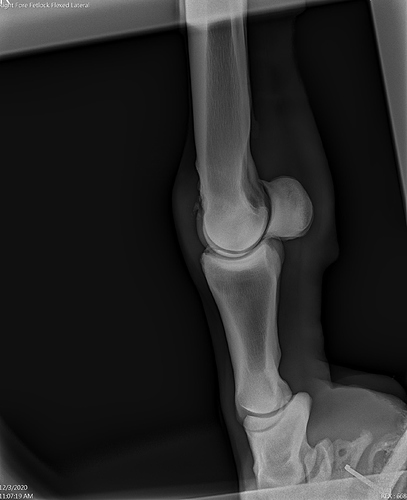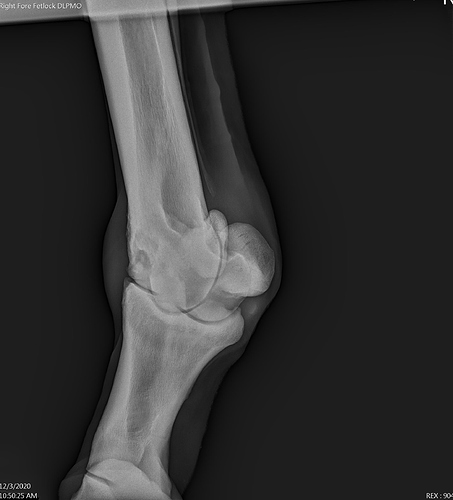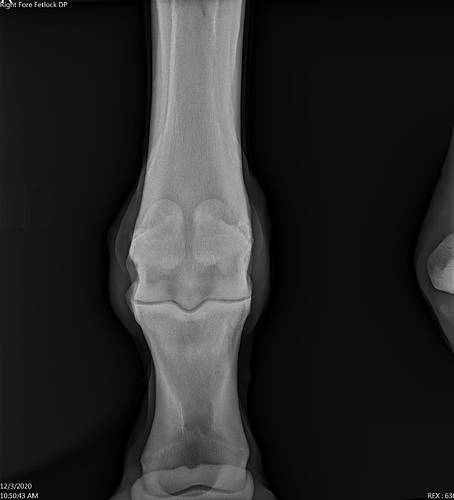Looking for opinions on what to do with my sales horse whose PPE x-rays revealed fetlock issues. I would love some input from people with more experience with OTTBs about just how horrible these x-rays are and how much they affect his prospects. I know horses don’t read their x-rays and there are a million stories on this forum about sound horses with crap x-rays…I just don’t know how concerned to be in this particular case.
The horse in question is a 6-year-old TB who’s been off the track for 2 years after 10 starts. He’s been sound in full work (dressage until started over fences 4 months ago) since coming off the track. He is a super nice horse with a lot going for him as far as temperament, movement, rideability, looks, size, etc. He even has great feet. He passed the soundness exam, including flexions, with flying colors.
His RF fetlock is visibly rounded (which I disclosed to every potential buyer in our first conversation) so I knew there would be an issue on x-rays but I underestimated the severity. I don’t have a written report so this is me paraphrasing the PPE vet: he has “moderate arthritis,” with chips around the front of the fetlock joint (including at least one in the joint) and spurs (my word) on the sesamoid that limit range of motion. The vet classified him as “high-risk for an athletic career,” so understandably the buyer walked. The LF fetlock had mild arthritis that the vet said is about par for the course for most OTTBs he sees. I’m waiting for a second opinion from my own vet on what his workload should be, whether it’s okay to continue jumping him, etc.
These are my options:
-
Return to previous owner, who has offered a guaranteed retirement home. I’m very grateful to have this option!
-
Continue marketing as a lower-level eventer/hunter/dressage horse, at a lower price. Knowing what the x-rays look like, I’m nervous about selling him to a stranger. I would always worry that even if I make it clear I will take him back at any time, they wouldn’t contact me if he went lame and he could end up in a bad place. I know that’s true for all horses but this one seems to be at higher risk, right? I also have no idea how to price him. 50% of original asking price? Less?
-
Free lease, give, or sell for a low price to a trusted person. I’ve already mentioned him to everyone in my personal network (which isn’t huge) and I’ve had some interest, so something may work out. Unfortunately I can’t continue in limbo without investing in shelter and cross-fencing for the winter because one of my other horses won’t let this poor sweet doofus eat hay in turnout and the grass is waning.
-
Keep him, continue developing and competing, and try to sell again in a year or two, at which point he will have proven his soundness further and there will be 2020 x-rays for comparison. This was the suggestion of my jumping coach, who is very experienced with OTTBs. I kind of doubt I would sell him for enough to break even so I’d have to decide that the costs of continuing to keep him would be worth my own enjoyment. I have been planning to focus my show/lesson budget on my other horse next year so I’m not sure how I feel about this option.
My priority is a great home and as secure a future as possible for the horse. I’m considering the money I’ve put into him to be lost regardless, though I guess there’s some possibility of recovering some of it.
Any educated opinions on these x-rays? What option would you choose?






